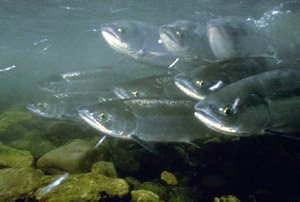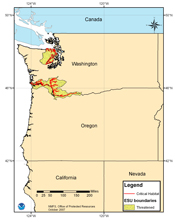Chum Salmon (Oncorhynchus keta)
Status | Taxonomy | Species Description | Habitat | Distribution |
Population Trends | Threats | Conservation Efforts | Regulatory Overview |
Key Documents | More Info
 Chum Salmon (Oncorhynchus keta) Photo: NOAA |
|
|
Did You Know? · Chum salmon are also called dog salmon. |
|
|
Status
ESA Threatened - 2 ESUs
More information on all 4 chum salmon ESUs is available on NMFS Northwest Regional Office website.
Taxonomy
Kingdom: Animalia
Phylum: Chordata
Class: Osteichthyes
Order: Salmoniformes
Family: Salmonidae
Genus: Oncorhynchus
Species: keta
Species Description
Second only to Chinook salmon in adult size, chum salmon individuals have been reported up to 3.6 feet (1.1 m) and 46 pounds (20.8 kg). However, average weight is around 8 to 15 pounds (3.6 to 6.8 kg).
Chum salmon are best known for the enormous canine-like fangs and striking body color of spawning males (a calico pattern, with the front two-thirds of the flank marked by a bold, jagged, reddish line and the posterior third by a jagged black line). Females are less flamboyantly colored and lack the extreme dentition of the males. Ocean stage chum salmon are metallic greenish-blue along the back with black speckles. They closely resemble both sockeye and coho salmon at this stage. As chum salmon enter fresh water, their color and appearance changes dramatically. Both sexes develop a "tiger stripe" pattern of bold red and black stripes.
In order to mate, chum salmon adults migrate from a marine environment into the freshwater streams and rivers of their birth (called anadromy). They spawn only once and then die (called semelparity). Unlike most species that rear extensively in fresh water, chum salmon form schools, presumably to reduce predation.
Chum salmon feed on insects and marine invertebrates while in rivers. As adults, their diet consists of "copepods", fishes, "mollusks", squid and "tunicates".
Age at maturity appears to follow a latitudinal trend in which a greater number of fish mature at a later age in the northern portion of the species' range. Most chum salmon mature and return to their birth stream to spawn between 3 and 5 years of age, with 60 to 90 percent of the fish maturing at 4 years of age. The species has only a single form (sea-run) and does not reside in fresh water. As the time for migration to the sea approaches, juvenile chum salmon lose their parr marks (vertical bars and spots useful for camouflage). They then gain the dark back and light belly coloration used by fish living in open water. They seek deeper water and avoid light; their gills and kidneys begin to change so that they can process salt water.
 Chum Salmon Critical Habitat (click for larger view PDF)  Chum Salmon Range Map (click for larger view PDF) |
Habitat
Chum salmon spawn in the lowermost reaches of rivers and streams, typically within 62 miles (100 km) of the ocean. Spawning sites are often near springs. They migrate almost immediately after hatching to estuarine and ocean waters, in contrast to other Pacific salmonids, which migrate to sea after months or even years in fresh water. This means that survival and growth in juvenile chum salmon depend less on freshwater conditions than on favorable estuarine and marine conditions.
Critical habitat was designated on September 2, 2005, for the threatened Columbia River ESU and Hood Canal Summer-run ESU.
Distribution
The species has the widest natural geographic and spawning distribution of any Pacific salmonid, primarily because its range extends farther along the shores of the Arctic Ocean than that of the other salmonids. Spawning populations are known from Korea and Japan and into the far north of Russia. Historically, in North America, chum salmon were distributed throughout the coastal regions of western Canada and the United States, as far south as Monterey, California. Presently, major spawning populations are found only as far south as Tillamook Bay on the northern Oregon coast.
Population Trends
Chum salmon may historically have been the most abundant of all Pacific salmonids. Seven of 16 historical spawning populations in the Hood River ESU are extinct. Recently some of these populations have shown encouraging increases in numbers, but the 2005 status review report [pdf] [6.3 MB] shows that the population trend overall is a 6% decline per year. In the Columbia River, historical populations reached hundreds of thousands to a million adults each year. In the past 50 years, the average has been a few thousand a year. Currently, it is thought that 14 of the 16 spawning populations in the Columbia River ESU are extinct. About 500 spawners occur in the ESU presently, and the long-term trend is flat.
Threats
Salmonid species on the west coast of the United States have experienced dramatic declines in abundance during the past several decades as a result of human-induced and natural factors. For more information, please visit our Pacific salmonids threats page.
Conservation Efforts
A variety of conservation efforts have been undertaken with some of the most common initiatives including captive-rearing in hatcheries, removal and modification of dams that obstruct salmon migration, restoration of degraded habitat, acquisition of key habitat, and improved water quality and instream flow.
The Pacific Coast Salmon Recovery Fund (PCSRF) was established by Congress in 2000 to support the restoration of salmon species. The fund is overseen by NMFS and carried out by state and tribal governments. The 2006 PCSRF report summarizes their work in detail.
No Pacific salmon have been evaluated for IUCN Redlist ![]() conservation status.
conservation status.
Regulatory Overview
The Columbia River ESU and Hood Canal Summer-run ESU were listed as threatened under the Endangered Species Act (ESA) on March 25, 1999. Their threatened status was reaffirmed on June 28, 2005.
A final critical habitat designation was published on September 2, 2005, with an effective date of January 2, 2006.
In addition, final revised protective regulations were issued on June 28, 2005.
See Key Documents below for more details.
Key Documents
(All documents are in PDF format.)
| Title | Federal Register | Date |
|---|---|---|
| Recovery Plan for Hood Canal Summer-run Chum | n/a | 05/2007 |
| Proposed Recovery Plan for Hood Canal ESU | 71 FR 47180 | 08/16/2006 |
| Designation of Critical Habitat for 12 ESUs of West Coast Salmon and Steelhead in Washington, Oregon, and Idaho | 70 FR 52630 | 09/02/2005 |
| ESA Listing Rule for Columbia River and Hood Canal summer-run ESUs Reaffirming ESA Status |
70 FR 37160 | 06/28/2005 |
| Status Review Update of All ESA-Listed ESUs | n/a | 06/2005 |
| Hood Canal Summer-run Chum Resource Management Plan | n/a | 06/12/2001 |
| Chum Salmon Federal Register Notices | n/a | various |
- NMFS Northwest Regional Office Chum Salmon ESU Information
- NMFS Northwest Regional Office Biological Status Reviews for Chum Salmon
- NMFS Pacific Salmonids: Major Threats and Impacts
- NMFS Critical Habitat Information
- U.S. Fish and Wildlife Service CyberSalmon Chum Salmon Information
- Washington Department of Fish and Wildlife Chum Salmon Information
